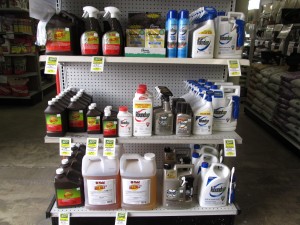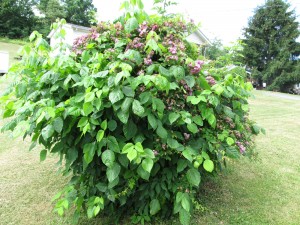Poison ivy (Toxicodendron radicans) is a woody perennial vine or small shrub that is grows wild in fields, woodlands, and home landscapes. As a vine, poison ivy has 3-leaf (trifoliate) compound leaves; leaf margins may be entire or tri-lobed. It is frequently misidentified as Virginia creeper (Parthenocissus quinquefolia), which has compound leaves with five rather than three leaflets. Poison ivy aggressively attaches itself to trees or other structures with hairy, aerial roots borne protruding along stems.
Poison ivy grows rapidly by underground rhizomes and seeds. Seeds are distributed by birds and other animals that eat the small fruits. Poison ivy often becomes entangled in shrubs and groundcovers making it difficult to control without harming desired plants growing nearby.
To eradicate poison ivy from your property, dress protectively. Wear a long-sleeved shirt, long pants and plastic (not cloth) gloves. Launder the clothing separately after spraying and discard the plastic gloves.
A number of chemical herbicides contain the following ingredients: glyphosate, triclopyr, 2,4-D amine, dicamba and mecoprop. Some garden centers sell a 3-way herbicide containing 2,4-D amine, dicamba and mecoprop.
Herbicides are applied to leaves and cut stems and translocated through the rest of the plant, killing entire shoots and roots. Repeated applications are often necessary, up to three times over a 2- month period before you successfully eradicated poison ivy, so be patient.
Herbicides work better when you spray at the right time. Poison ivy is most sensitive in mid-summer after leaves have fully expand and before autumn leaf color starts. Glyphosate (Roundup® or equivalent) offers the best control when mixed as a 2% solution (approx. 2 TBSP per gallon).
In residential lawns, a 3-way herbicide may be applied to tall fescue, bermudagrass, zoysiagrass, St. Augustinegrass and centipedegrass for poison ivy control. Glyphosate, 2,4-D amine, dicamba, mecoprop and triclopyr are translocated through grass blades and cut stems to grass crowns and roots. Repeat spraying as needed.
Always read and follow pesticide labels.



 Posted in
Posted in 
